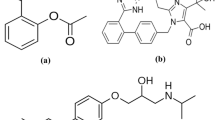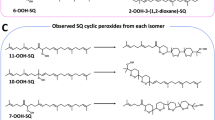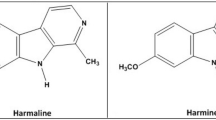Abstract
The l-tryptophan–derived tricyclic hydroperoxide cis-WOOH was recently identified as a novel and biologically important factor for regulating vascular tone and blood pressure under inflammatory conditions and potentially other cellular redox signaling events. cis-WOOH is highly labile and currently not available commercially. In this protocol, we provide procedures for the synthesis, purification, quantification and characterization of cis-WOOH, its epimer trans-WOOH and their respective alcohols (cis-WOH and trans-WOH). Photo-oxidation of l-tryptophan (l-Trp) results in a mixture containing cis-WOOH and trans-WOOH, which are separated and purified by semi-preparative HPLC. cis-WOH and trans-WOH are then produced by sodium borohydride reduction and purified by semi-preparative HPLC. Characterization of cis-WOOH and trans-WOOH and the reduced alcohol variants is achieved using HPLC, fluorescence, NMR and liquid chromatography-tandem mass spectrometry. The protocol provides instructions for storage and quantification, as well as ways to test the stability of these hydroperoxides in commonly used buffers and media. Finally, we describe examples of how to monitor the formation of cis-WOOH in biological samples. The protocol ensures reasonable yield (11%) and purity (>99%) of cis-WOOH and control compounds in 5–6 d and outlines conditions under which cis-WOOH is stable for several months.
This is a preview of subscription content, access via your institution
Access options
Access Nature and 54 other Nature Portfolio journals
Get Nature+, our best-value online-access subscription
$29.99 / 30 days
cancel any time
Subscribe to this journal
Receive 12 print issues and online access
$259.00 per year
only $21.58 per issue
Buy this article
- Purchase on Springer Link
- Instant access to full article PDF
Prices may be subject to local taxes which are calculated during checkout








Similar content being viewed by others
Data availability
All the data relating to this protocol are present in the paper and its associated source files or can be found in the supporting primary research papers.
References
Winterbourn, C. C. & Hampton, M. B. Thiol chemistry and specificity in redox signaling. Free Radic. Biol. Med. 45, 549–561 (2008).
Winterbourn, C. C. Reconciling the chemistry and biology of reactive oxygen species. Nat. Chem. Biol. 4, 278–286 (2008).
Stanley, C. P. et al. Singlet molecular oxygen regulates vascular tone and blood pressure in inflammation. Nature 566, 548–552 (2019).
Wakita, C. et al. Stereochemical configuration of 4-hydroxy-2-nonenal-cysteine adducts and their stereoselective formation in a redox-regulated protein. J. Biol. Chem. 284, 28810–28822 (2009).
Stanley, C. P. & Stocker, R. Regulation of vascular tone and blood pressure by singlet molecular oxygen in inflammation. Curr. Opin. Nephrol. Hypertens. 30, 145–150 (2021).
Fiore, A. & Murray, P. J. Tryptophan and indole metabolism in immune regulation. Curr. Opin. Immunol. 70, 7–14 (2021).
Ronsein, G. E., Oliveira, M. C., Miyamoto, S., Medeiros, M. H. G. & Di Mascio, P. Tryptophan oxidation by singlet molecular oxygen [O2(1∆g)]: mechanistic studies using 18O-labeled hydroperoxides, mass spectrometry, and light emission measurements. Chem. Res. Toxicol. 21, 1271–1283 (2008).
Nakagawa, M. et al. Dye-sensitized photooxygenation of tryptophan: 3a-hydroperoxypyrroloindole as a labile precursor of formylkynurenine. Chem. Pharm. Bull. (Tokyo) 29, 1013–1026 (1981).
Saito, I., Matsuura, T., Nakagawa, M. & Hino, T. Peroxidic intermediates in photosensitized oxygenation of tryptophan derivatives. Acc. Chem. Res. 10, 346–352 (1977).
Gracanin, M., Hawkins, C. L., Pattison, D. I. & Davies, M. J. Singlet-oxygen-mediated amino acid and protein oxidation: formation of tryptophan peroxides and decomposition products. Free Radic. Biol. Med. 47, 92–102 (2009).
Michaeli, A. & Feitelson, J. Reactivity of singlet oxygen toward amino acids and peptides. Photochem. Photobiol. 59, 284–289 (1994).
Wolff, S. P. Ferrous ion oxidation in presence of ferric ion indicator xylenol orange for measurement of hydroperoxides. Methods Enzymol. 233, 182–189 (1994).
Jessup, W., Dean, R. T. & Gebicki, J. M. Iodometric determination of hydroperoxides in lipids and proteins. Methods Enzymol. 233, 289–303 (1994).
Thomas, S. R., Mohr, D. & Stocker, R. Nitric oxide inhibits indoleamine 2,3-dioxygenase activity in interferonγ-primed mononuclear phagocytes. J. Biol. Chem. 269, 14457–14464 (1994).
Beers, R. F. Jr. & Sizer, I. W. A spectrophotometric method for measuring the breakdown of hydrogen peroxide by catalase. J. Biol. Chem. 195, 133–140 (1952).
Toledo, J. C. Jr. et al. Horseradish peroxidase compound I as a tool to investigate reactive protein-cysteine residues: from quantification to kinetics. Free Radic. Biol. Med. 50, 1032–1038 (2011).
Acknowledgements
We thank C. Stanley and G. Maghzal for their assistance with some of the experiments and J. Talib, J. Gebicki, P. Di Mascio and G.E. Ronsein for their advice. This work was funded by Program Grant 1052616 from the National Health and Medical Research Council of Australia (NHMRC) to R.S. R.S. is supported by NHMRC Senior Principal Research Fellowship 1111632. The work also received support from New South Wales Health.
Author information
Authors and Affiliations
Contributions
A.A. and R.S. designed the study. R.F.Q., C.S. and S.S. carried out the synthesis and purification of l-Trp–derived hydroperoxides. R.F.Q. and C.S. designed and carried out purification of cis- and trans-WOH. R.F.Q. determined extinction coefficients of cis- and trans-WOOH and the corresponding alcohols. R.F.Q. compared hydroperoxide quantification methods. C.S. performed purity testing of all compounds by LC-MS/MS and HPLC-UV. R.F.Q. and C.S. performed stability studies. R.F.Q. carried out and determined the LOD and LOQ of the hydroperoxides and their corresponding alcohols. S.S. and R.J.P. designed, performed and interpreted NMR studies. L.C. and R.J.P. designed, performed and interpreted optical rotation and IR characterization of compounds. G.E.S. and A.A. designed and performed fluorescence studies. All authors interpreted data. R.F.Q., A.A., C.S. and R.S. drafted the manuscript, and all authors critically reviewed the draft manuscript. A.A. and R.S. revised the manuscript, and all authors approved the submitted versions of the manuscript.
Corresponding authors
Ethics declarations
Competing interests
The authors declare no competing interests.
Additional information
Peer review information Nature Protocols thanks Camilo López-Alarcón and the other, anonymous, reviewer(s) for their contribution to the peer review of this work.
Publisher’s note Springer Nature remains neutral with regard to jurisdictional claims in published maps and institutional affiliations.
Related links
Key reference using this protocol
Stanley, C. P. et al. Nature 566, 548–552 (2019): https://doi.org/10.1038/s41586-019-0947-3
Extended data
Extended Data Fig. 1 Correlation between absorbance and cis-WOH and trans-WOH concentrations in nanopure H2O containing DTPA (100 µM).
Aliquots of cis-WOOH and trans-WOOH (5 mM; determined by the iodometric method) were incubated with a 20-fold molar excess of NaBH4 (100 mM) for 20 min at room temperature. cis-WOOH was dissolved in HPLC-grade water, whereas trans-WOOH was dissolved initially in DMSO and then diluted to 30% DMSO with nanopure grade H2O. The solutions were then diluted to 10, 25, 50, 100 and 250 µM in nanopure grade H2O before recording their spectra from 400 to 200 nm using a spectrophotometer. Absorbance was plotted against cis- or trans-WOH concentration, and their respective molar extinction coefficients at 295 nm were obtained from the slope as ε = 2.76 ± 0.05 × 103 and ε = 2.23 ± 0.03 × 103 M–1 cm–1. Data are mean ± s.e.m. and are representative of three independent experiments.
Extended Data Fig. 2 Fluorescence spectra of cis-WOOH, cis-WOH, trans-WOOH and trans-WOH.
a, Excitation and emission spectra of 50 µM cis-WOOH and cis-WOH. b, Excitation and emission spectra of 50 µM trans-WOOH and trans-WOH. Spectra were determined using a Duetta fluorescence and absorbance spectrophotometer (Horiba Scientific). cis-WOOH and cis-WOH were analyzed in milliQ water whereas trans-WOOH and trans-WOH were analyzed in 50:50 (vol:vol) milliQ water/DMSO. All readings were taken at 20 oC.
Rights and permissions
About this article
Cite this article
Queiroz, R.F., Suarna, C., Corcilius, L. et al. Preparation, validation and use of a vasoactive tryptophan-derived hydroperoxide and relevant control compounds. Nat Protoc 16, 3382–3418 (2021). https://doi.org/10.1038/s41596-021-00541-1
Received:
Accepted:
Published:
Issue Date:
DOI: https://doi.org/10.1038/s41596-021-00541-1
This article is cited by
Comments
By submitting a comment you agree to abide by our Terms and Community Guidelines. If you find something abusive or that does not comply with our terms or guidelines please flag it as inappropriate.



